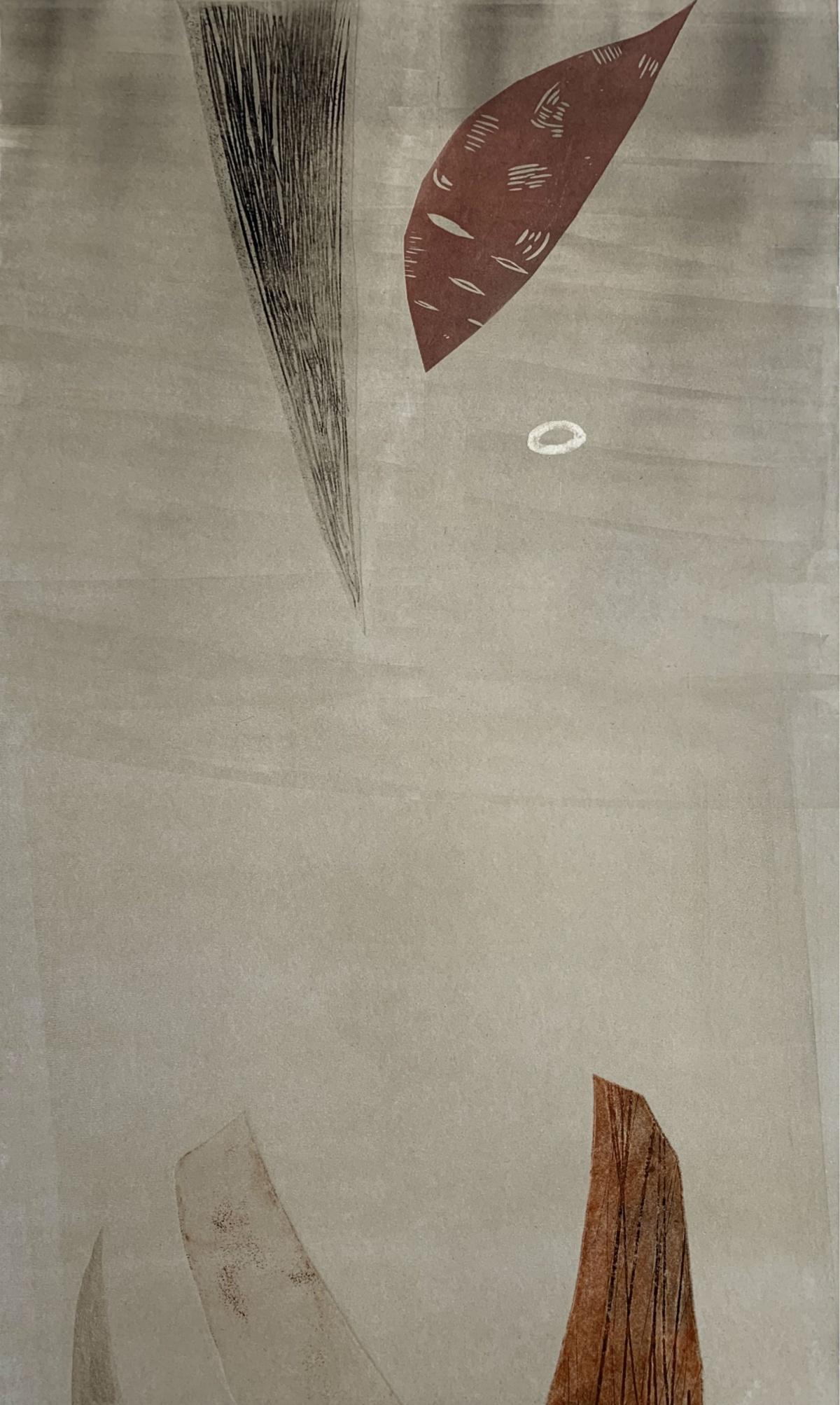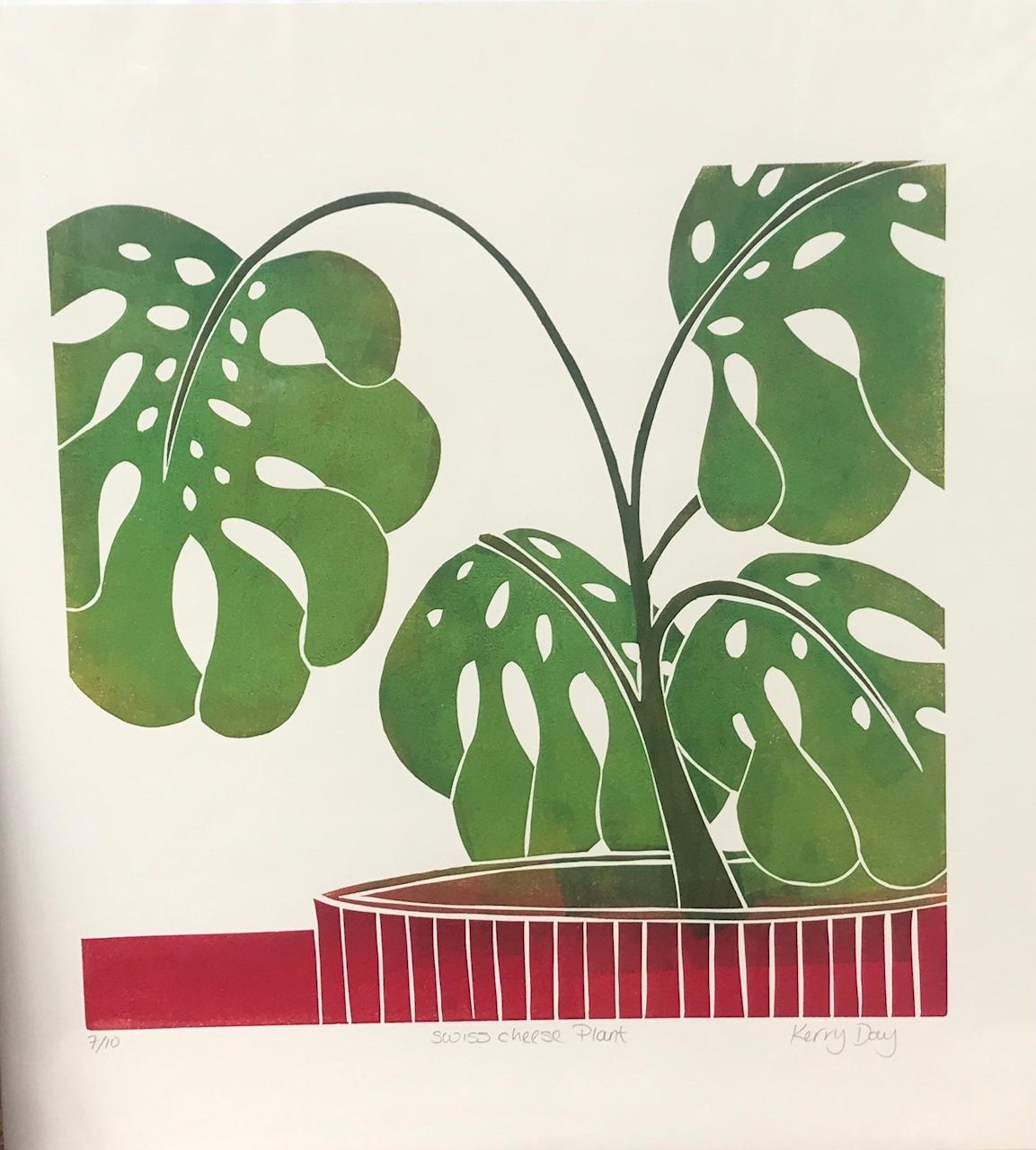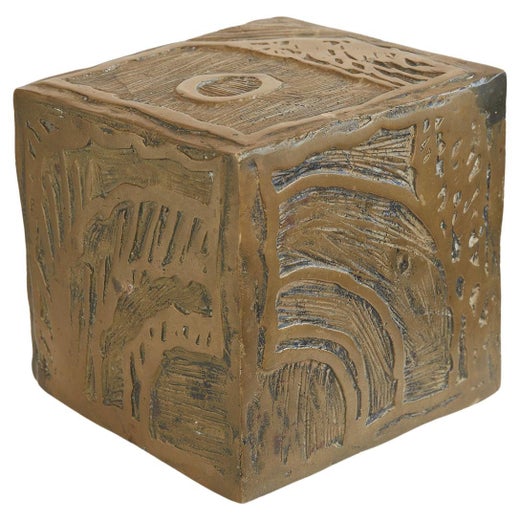Items Similar to Lino Litho BR, Planche IX
Want more images or videos?
Request additional images or videos from the seller
1 of 13
Pierre AlechinskyLino Litho BR, Planche IX1970
1970
About the Item
Lino Litho BR, Planche IX
Linocut and lithograph, 1970
Signed lower right of central image (see photo)
Edition: 99 (56/99) (see photo)
Published by London Arts Group, Detroit
Condition: Excellent
Image size: 15 x 21 1/2 inches
Note: The recipient of the Andrew Mellon Prize in 1977, Alechinsky is represented in the collections of sixty-five of the world's leading
museums
Pierre Alechinsky
B. 1927, BRUSSELS
Born on October 19, 1927, in Brussels, Pierre Alechinsky grew up with varied artistic interests that included graphic techniques, folk art, and medieval book illustrations. From 1944 to 1948 he studied art at the École nationale supérieure d'architecture et des arts décoratifs (La cambre), Brussels. Alechinsky joined the group Jeune Peinture Belge (also known as Jonge Belgische Schilderkunst, young Belgian painters, 1945–48) and had his first solo exhibition in the Galerie Lou Cosyn, Brussels, in 1947. During a stay in Paris in 1948, he was deeply impressed by the work of Jean Dubuffet and Max Ernst, feeling particularly drawn to the former's Art Brut. In March 1949, Alechinsky visited an exhibition featuring artists from the Cobra group (1948–51) at the Séminaire des arts, an experience that would have a lasting effect. Formed by painters from Copenhagen, Brussels, and Amsterdam, the movement distinguished itself through bold, expressive compositions inspired by folk and children's art, as well as by the work of Paul Klee and Joan Miró.
From 1949 to 1951, Alechinsky devoted himself so intensely to Cobra—organizing exhibitions and running the group's eponymous magazine (eight issues, 1949–51)—that he produced little work of his own. His distinctive use of script as a means of pictorial expression came out of his exposure to Cobra artists such as Karel Appel and Asger Jorn, and in 1951 he moved to Paris to study engraving. While there, he discovered an interest in Asian calligraphy. He traveled to Japan in 1955 and the following year made Calligraphie japonaise, a film about Japanese calligraphers. Fascinated by the way they placed paper on the floor and bent over, using their entire bodies to make their works, Alechinsky adopted the method.
Around 1958, his subject matter became more fantastic in nature, and he began using brightly colored acrylics to render comically deformed creatures that often communicate via speech bubbles. The creatures recall Hieronymus Bosch, Pieter Brueghel, and James Ensor—Flemish painters that Alechinsky admires and to whom he sometimes pays homage in his paintings. Since the mid-1960s, Alechinsky has worked primarily on paper. He has returned to his roots as a student in Brussels in his later work that refers to medieval pictorial illustration. From 1983 to 1987 he was a professor of painting at the École nationale supérieure des beaux-arts, Paris. His work has been included in group exhibitions at the Institute of Contemporary Arts, London (1958); Venice Biennale (1960, 1972); Pittsburgh International (now Carnegie International, 1961, 1977); São Paulo Biennial (1963, 1989); and Guggenheim Museum (2009), among other venues. He has received numerous international solo exhibitions at institutions as diverse as the Palais des beaux-arts, Brussels (1955, 1969); Stedelijk Museum, Amsterdam (1963); Museum of Fine Arts, Houston (1967); Musée national d'art moderne Centre Georges Pompidou, Paris (1975, 2004); Guggenheim Museum (1987); Taipei Fine Arts Museum (1992); and Jeu de Paume, Paris (1998, 2003). Museés royaux de beaux-arts de Belgique, Brussels, mounted a major retrospective in 2007. Alechinsky lives and works in Paris.
Courtesy Gugenheim
- Creator:Pierre Alechinsky (1927, Belgian)
- Creation Year:1970
- Dimensions:Height: 15 in (38.1 cm)Width: 21.5 in (54.61 cm)
- Medium:
- Movement & Style:
- Period:
- Condition:
- Gallery Location:Fairlawn, OH
- Reference Number:
Pierre Alechinsky
Pierre Alechinsky is a belgian painter born in 1927 in Brussels. Attracted by painting, Pierre Alechinsky begins aged 17 in the Ecole Nationale Supérieure d'Architecture et des Arts Décoratifs de la Cambre in Brussels. He was involved in the Cobra artistic movement with Karel Appel and Asger Jorn and organised exhibitions. In the early fifties, he learnt the art of engraving with Stanley William Hayter and also Japanese calligraphy. He met Giacometti, Bram Van Velde, and Victor Brauner. In 1955, he signs for his first exhibition at the Palais des Beaux-Arts de Bruxelles, then at the Institute of Contemporary Arts of London. His artworks, prints, lithographies, engravings and books illustrations can also be found in the USA, in France, in the Netherlands, Denmark and Germany. On and after 1965, fascinated by the Oriental calligraphy, he uses acrylic painting, ink, different types of paper as bills, and gets carried away by action painting technique. During the eighties, he became for four years a teacher of plastic arts at the Ecole Nationale Supérieure des Beaux Arts. Also a writer, Pierre Alechinsky published many books including «Titres et pains perdus », « Baluchon et ricochets », and in 2004 «Des deux mains ». He lives and works in France.
About the Seller
5.0
Recognized Seller
These prestigious sellers are industry leaders and represent the highest echelon for item quality and design.
Platinum Seller
These expertly vetted sellers are 1stDibs' most experienced sellers and are rated highest by our customers.
Established in 1978
1stDibs seller since 2013
718 sales on 1stDibs
Typical response time: 1 hour
Associations
International Fine Print Dealers Association
- ShippingRetrieving quote...Ships From: Fairlawn, OH
- Return PolicyA return for this item may be initiated within 10 days of delivery.
More From This SellerView All
- Untitled (pour XXe Siecle)By Alberto MagnelliLocated in Fairlawn, OHLinocut, printed on yellow wove paper Unsigned as is usual From: XXe Siecle, Volume 13, 1959 Published by G. San Lazzaro for A. Maeght, Paris Printed by...Category
1950s Abstract Geometric Abstract Prints
MaterialsLinocut
- Icare- IcarusBy André VerdetLocated in Fairlawn, OHIcare- Icarus Linocut in colors, 1972 Unsigned Stamped in ink on verso: "Imprimerie Arnéra" Archives/ Non Signé Provenance: Arnéra Archive Frederick Mulder, Lt...Category
1970s Abstract Abstract Prints
MaterialsLinocut
- Déesse- GoddessBy André VerdetLocated in Fairlawn, OHDéesse- Goddess Linocut in colors, 1972 Unsigned Stamped in ink on verso: "Imprimerie Arnéra" Archives/ Non Signé Watermark: Arches (see photo) An impression printed in black, purpl...Category
1970s Abstract Abstract Prints
MaterialsLinocut
- Lino Litho BR, Planche VIBy Pierre AlechinskyLocated in Fairlawn, OHLino Litho BR, Planche VI Linocut and lithograph, 1970 Signed lower right in pencil (see photo) Edition: 99 (56/99) (see photo) Published by London Arts Group, Detroit Condition: Exc...Category
1970s Abstract Abstract Prints
MaterialsLinocut
- Icare- IcarusBy André VerdetLocated in Fairlawn, OHIcare- Icarus Linocut in colors, 1972 Unsigned Stamped in ink on verso: "Imprimerie Arnéra" Archives/ Non Signé Provenance: Arnéra Archive Frederick Mulder, Lt...Category
1970s Abstract Abstract Prints
MaterialsLinocut
- Terres de Grand Feu, (Land of Great Fire)By Joan MiróLocated in Fairlawn, OHDerriere le miroir, no. 87-88-89. Pages 6-7 Terres de Grand Feu, (Land of Great Fire) Color lithograph, 1956 From: Derriere le Miroir, Volume 87-8...Category
1950s Abstract Abstract Prints
MaterialsLithograph
You May Also Like
- Non-accidental shapes - XX Century, Colorful Woodcut & Linocut, Abstract PrintBy Ryszard GieryszewskiLocated in Warsaw, PLRYSZARD GIERYSZEWSKI (born in 1936) Graduated from the Academy of Fine Arts in Warsaw in 1964. He is a member of International Association XYLON in Switzerland. He participated in mo...Category
Early 2000s Abstract Abstract Prints
MaterialsPaper, Linocut, Woodcut
- Untitled - Mixed print technique, Contemporary abstract printBy Berenika Korecka-SowinskaLocated in Warsaw, PLMixed media print on paper by young Polish artist Berenika Korecka-Sowinska who graduated in 2009 from Academy of Fine Arts in WarsawCategory
2010s Abstract Abstract Prints
MaterialsLinocut, Paper, Etching, Aquatint
- Untitled - Mixed print technique, Contemporary abstract printBy Berenika Korecka-SowinskaLocated in Warsaw, PLMixed media print on paper by young Polish artist Berenika Korecka-Sowinska who graduated in 2009 from Academy of Fine Arts in WarsawCategory
2010s Abstract Abstract Prints
MaterialsEtching, Paper, Aquatint, Linocut
- I from La Magnanerie de la Ferrage, Cubist Linocut by Alberto MagnelliBy Alberto MagnelliLocated in Long Island City, NYArtist: Alberto Magnelli, Italian (1888 - 1971) Title: I from La Magnanerie de la Ferrage Year: 1971 Medium: Linocut on Japon, signed in pencil Edition: Pour Leon Amiel Image Si...Category
1970s Abstract Geometric Abstract Prints
MaterialsRice Paper, Linocut
- Kerry Day, Swiss Cheese Plant, Limited Edition Print, Floral Art, Bright ArtBy Kerry DayLocated in Deddington, GBKerry Day Swiss Cheese Limited Edition 7 Layered Linocut Print Edition of 10 Image Size: H 30.4cm x W 30.5cm Sheet Size: H 43cm x W 42cm x D 0.1cm Sold Un...Category
21st Century and Contemporary Abstract Geometric Still-life Prints
MaterialsPaper, Linocut
- California Abstract Expressionist Linocut Lithograph Sepia Print Edition of 6By Hans BurkhardtLocated in Surfside, FLUntitled, 1983, lithograph printed in sepia ink, Hand signed and dated lower right, numbered in pencil with the artist's chop mark lower left, inscribed by artist. From a series of experimental abstract linocuts done in 1983. These are very small editions and were gifted to a friend of the artist. They are done on deckle edged French Arches Art paper. Hans Gustav Burkhardt (1904 – 1994) was a Swiss-American abstract expressionist artist. Hans Burkhardt was born in the industrial quarter of Basel, Switzerland. Captivated by Germanic art, he began dabbling in art in his spare time while learning how to decorate furniture in antique styles. He became foreman of the furniture company's decorating department. From 1925 to 1928 he attended the Cooper Union School of the Arts, where he befriended mentor Arshile Gorky and Willem de Kooning—sharing Gorky's studio from 1928 to 1937. Burkhardt's paintings of the 1930s are part of the genesis of American abstract expressionism. In 1937 he moved to Los Angeles and represented the most significant bridge between New York and Los Angeles. His experimental investigative approach paralleled, and in many instances anticipated, the development of modern and contemporary art in New York and Europe including the work of Mark Rothko, Jackson Pollock, and Barnett Newman. Burkhardt held his first solo exhibition in 1939 at Stendahl Gallery in Los Angeles, arranged by Lorser Feitelson, and, in response to the Spanish Civil War, he painted his first anti-war works. From the late 1930s he began to produce apocalyptic anti-war compositions, a theme which became particularly pronounced in an abstract expressionist style after the atom bomb was dropped on Hiroshima and Nagasaki at the end of the Second World War. In the years following an acclaimed (1945) solo exhibition at the Los Angeles County Museum, Burkhardt continued in his art to respond to WWII, in the aftermath of Gorky's suicide in 1948, Burkhardt delved into his grief and celebration of Gorky's life creating several versions of “Burial of Gorky” and a series entitled “Journey into the Unknown.” Burkhardt first visited Mexico in 1950, and spent the next decade living half of the year in and around Guadalajara. Strongly influenced by Mexican attitudes towards the dead, and by the country's colors, sensuality, and spiritual qualities, Burkhardt “painted the soul of Mexico” with Mexican themes and colors—especially those of burials and ceremonies surrounding death—permeating his abstract work. His Mexican work flirted with Surrealism although he was never really considered a Surrealist artist. Art critics of the time considered him a "great Mexican master” alongside Orozco, Diego Rivera, and Siqueiros, and Rufino Tamayo admired his work. Overall, in the 1950s Burkhardt held 23 solo exhibitions in Los Angeles and Mexico, and participated in group shows at over thirty museums worldwide. He was friends with June Wayne from Tamarind Press. In the 1960s he produced paintings in protest against the Vietnam War, some of which incorporated the human skulls he had collected from Mexican graveyards. As art historian Donald Kuspit stated, Burkhardt was “a master—indeed the inventor—of the abstract memento mori.” In 1964, for the first time in forty years, Burkhardt returned to Basel, and began making annual summer visits where he became a friend of Mark Tobey—printing linocuts for the artist and collecting his work. In the 1970s Burkhardt continued his anti-war paintings—incorporating protruding wooden spikes into the canvas—while simultaneously painting abstractions of merging lovers and cityscapes during his summer visits to Basel. His “Small Print” (protesting smoking), “Graffiti,” and “Northridge” series demonstrate the evolution of his symbolism, and his “Desert Storms” series, in response to Iraq's invasion of Kuwait, was discussed by critic Peter Selz at a presentation at the International Congress of Art Critics Conference. In the last decades of his life, Burkhardt's work had moved from images of imbalance to a study of human tragedy—which he embraced in an attempt to discover beauty and facilitate understanding. Critic Peter Frank called Burkhardt “…one of America’s most vital abstract expressionist painters, someone who took the seed of the movement and cultivated it a rather different way in very different soil.” Burkhardt taught at numerous colleges and universities and retired as a professor emeritus from California State University, Northridge. In 1992 Burkhardt was honored as the recipient of the Lifetime Achievement Award by the American Academy and Institute of Arts and Letters’ Jimmy Ernst (son of Max Ernst) Award. Also in 1992, he established the Hans G. and Thordis W. Burkhardt Foundation. In 1993, the last year of his career, his final series “Black Rain” channeled pain and hardship, but provided poignant, symbolic beacons of hope and wishes for a better future for humanity. His unique role as an important American painter is affirmed by the constant interest and continuing reassessment afforded his work. Select Solo exhibitions 1939: Stendahl Gallery, Los Angeles, March 27 – April 17 1945: Hans Burkhardt, Los Angeles County Museum of Art 1951: Museo de Bellas Artes, Guadalajara, Mexico: Exhibición de Pinturas Modernas; Comara Gallery, Los Angeles 1953: Fisher Gallery, University of Southern California, Los Angeles 1957: Pasadena Art Museum, California: Ten Year Retrospective, June 14 – July 14; 1968: San Diego Museum of Art: Vietnam Paintings...Category
1980s Abstract Expressionist Abstract Prints
MaterialsLithograph, Linocut






